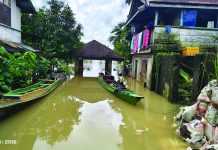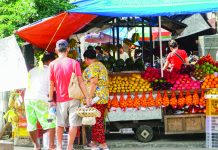Homonhon mining activities

TACLOBAN CITY – In a powerful show of pastoral and environmental solidarity, the three Catholic bishops of Samar Island visited Homonhon Island in Guiuan, Eastern Samar, lending their voices to local communities opposing the continued expansion of large-scale mining operations on the historically significant island.
Bishops Nolly Buco of the Diocese of Catarman, Isabelo Abarquez of the Diocese of Calbayog, and Crispin Varquez of the Diocese of Borongan made the visit on July 28 as part of the 50th general assembly of the Samar Island Partnership for Peace and Development (SIPPAD), a multi-sectoral network advocating sustainable development and environmental justice.
The decision to hold the milestone assembly on Homonhon was deliberate, organizers said, aiming to refocus attention on the enduring struggles of island residents against environmental degradation and threats to livelihood brought about by decades of mining.
“Holding the SIPPAD Assembly on Homonhon Island was not by chance. We wanted to return to the very heart of why SIPPAD exists—our love for our people and our sacred duty to care for the land that gives us life,” said Fr. James Abella, director of the Commission on Social Action, Justice and Peace of the Diocese of Borongan.
Fr. Abella said the bishops’ presence on the island signaled not just spiritual care but an unequivocal stance against further destruction. Residents say ongoing mining has led to severe soil erosion, siltation of waterways, deforestation, and loss of farmland and water sources.
Homonhon, where Ferdinand Magellan first landed in the Philippines over 500 years ago, is now home to over 4,000 residents spread across eight barangays. The island has hosted large-scale mining since the 1980s. At present, four mining firms operate there: Global Min-Met Resources, Verum Terra Geosciences Inc., TelcIron Resources Inc., and Emir Mineral Resources Corp.
A fresh wave of opposition erupted this July after Emir Mineral Resources began clearing land for a proposed 25-hectare expansion in Barangay Casuguran—an area close to homes, farms, and a secondary school.
Carmi Macapagao, president of the Homonhon Environmental Advocates and Rights Defenders (HEARD), said residents began a peaceful barricade on July 14 to stop the expansion.
“The visit of the bishops came at a very crucial time,” she said. “They’ve already begun clearing operations. In the process, three vegetable and calamansi farms were destroyed, and around 60 mancono trees were felled.”
The mancono, or Philippine ironwood (Xanthostemon verdugonianus), is a rare and endangered tree species endemic to the Philippines.
Macapagao warned that the proposed expansion area is part of the community’s agricultural zone and could affect the water supply and the only public high school on the island.
Fr. Abella added that the bishops are planning to return to Barangay Casuguran in September to lead a tree-planting activity as part of the Catholic Church’s annual Season of Creation, observed from September 1 to October 4.
The tradition, rooted in Pope Francis’ 2015 encyclical Laudato Si’, calls on Christians worldwide to engage in ecological conversion and take action to protect the environment.
Efforts to get a comment from Emir Mineral Resources Corp. about the protests and their planned expansion remained unanswered as of press time.
JOEY A. GABIETA



